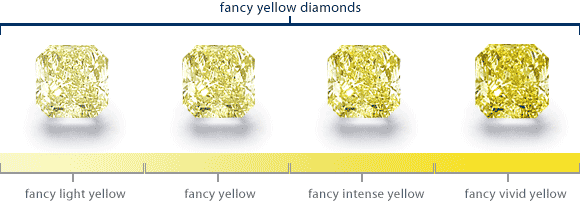Fancy Color Diamonds
Only one in every 10,000 diamonds posseses natural color and is referred to as a fancy color diamond. The 4Cs; cut, color, clarity, and carat weight, are the main criteria to consider when purchasing a colorless (white) or fancy color diamond.
While colorless diamonds are graded on a color scale with colorless being the most desirable, the intensity of color, is the primary consideration when purchasing a fancy color diamond. The rarer and more valuable diamonds have the most intense color. Fancy color diamonds are graded on a color scale in order of increasing intensity from Faint, Very Light, Light, Fancy Light, Fancy, Fancy Intense, Fancy Vivid, Fancy Dark, and Fancy Deep.

Following color grade, carat weight has the most impact on price when purchasing any diamond. Large gems are discovered less frequently than small ones, making them more rare and valuable.
Inclusions tend to be masked by the color of the diamond making the clarity much less important in a fancy color diamond than in colorless diamonds.
Colorless diamonds are cut to maximize the brilliance, or sparkle of the stone. Fancy color diamonds on the other hand are cut primarily to emphasize their color. Although color diamonds still display brilliance, color is the highest characteristic consider when they are being cut.
There are many different colors of fancy color diamonds including, blue, yellow, pink, green, and black. Each color is formed by a different natural substance.
When boron replaces the nitrogen inside a diamond, it reflects the blue light of the wavelength, creating a blue diamond. The more boron inside the diamond, the more vivid the color.
When impurities are trapped inside the stone while it is being created, a yellow hue is displayed. The intensity of the color is determined by how many nitrogen atoms are trapped within the diamond, which causes the yellow light on the spectrum to be reflected.
Pink diamonds are not formed from the impurites inside the stone, but rather from a process called plastic deformation. The different pressures will cause the color of the stone to be different, pale or bright.
When a diamond has been affected by a radioactive source during it’s creation a green diamond is formed. Green diamonds can take more than a million years to form, which makes them quite rare.
Central Africa and Brazil are the only two known places in the world to find black diamonds. These diamonds contain nitrogen and hydrogen, which give the diamond it’s black appearance. Scientists have a recent theory that these diamonds may have begun as carbon dust and fallen to Earch as meteorites.

